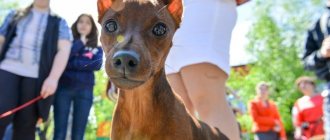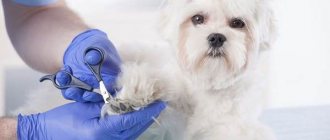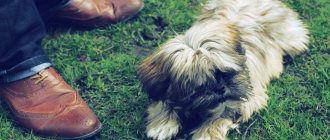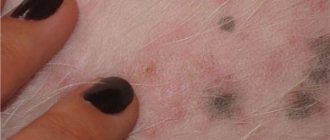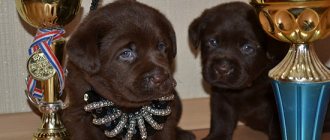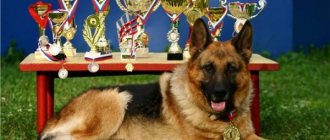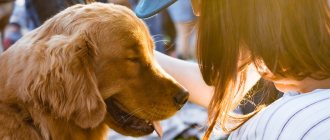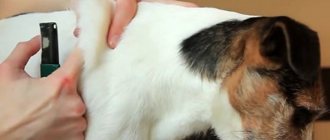A dog's conformation is a description of the animal's appearance. These are evaluation criteria, descriptions of body parts. Each of the dog's articles performs a specific function. Therefore, it is important for specialists to establish the relationship between the appearance of body parts and their functionality. This helps improve the quality of the breed.
A purebred dog must meet the criteria
The dog's conformation is the purpose of selection
Each breed has its own standards for the appearance of a dog. Specialists ensure that changes do not go beyond established boundaries. The health of the dog and the preservation of its main qualities depend on this.
Thus, the main goal of the exterior is to maintain certain standards and improve the breed.
Other goals - maintaining health and beneficial qualities depend on the main criterion. A manual with a description of the articles and regulations is necessary for judges and experts at exhibitions. Important! Representatives of different breeds will have different exterior features.
Sense organs
Of all the senses, dogs have the best developed sense of smell. The nasal mucosa is covered with nerve endings that are responsible for recognizing many different, sometimes subtle odors. Some individuals are able to smell game hundreds of meters away. They can also remember smells, for example, so they can track prey later.
In second place in terms of sensitivity is hearing. The dog distinguishes sounds in the range of 45,000 Hz and does not lose hearing even if the eardrum is damaged. Things are much worse with vision. An adult is able to distinguish objects only at a distance of 40 meters. At the same time, puppies see better than their older brothers.
Exterior concept
In dog breeding, this name refers to a system of patterns for assessing the appearance of a dog. With its help, specialists can identify deviations from generally accepted standards. Conformation is a rating system that takes into account the diversity of breeds.
In addition, the criteria explain the features and relationships between the dog’s characteristics. But this is the concept of a general exterior. There is also a private one that considers each breed separately. All breeds are different from each other, and this is due to the fact that they were bred for different purposes.
The exterior is assessed by professionals
Stati dogs
Dog handlers distinguish 52 parts of the body, which are called “articles”. It is they who determine the exterior, on the basis of which they give marks in competitions, and determine the deviation from the norm. You can see all the characteristics of the dog on the diagram. They are grouped into large groups:
- Scull. Specialists pay attention to the frontal part, nasal and ear areas. Dog handlers are also interested in “stop” – this is the angle of transition between the frontal and nasal areas. Experts pay attention to less pronounced parts - cheekbones, parotid, cheek and chewing. Not only the shape, size, but also the color of certain anatomical parts are important.
- The head is an important criterion for assessing the appearance of a dog. Pay attention to size, shape, proportions. Conventionally, the head is divided into two main sections - posterior and anterior. Dog trainers look at the proportions of the parts to determine compliance with breed standards.
- The neck affects head posture because it regulates the dog's center of gravity. The ability to maintain balance depends on this. The position of the neck changes according to the phase of movement.
- Forelegs - evaluate their length, symmetry, color, shape of pads and length of claws.
- Dog Chest – Different breeds will have different lengths, depths and widths.
- The hind limbs differ from the forelimbs in their larger size and massiveness. The strength of the pet's jerk when jumping depends on their structure. For example, like a Labrador.
- Tail - its length, color, shape will be different in all breeds. This is also an important criterion for assessing a dog’s exterior.
In some breeds, slight deviations from the norm in one or more criteria are acceptable. Often breeders cross breeds to enhance certain qualities. The result is a new variety, for which their own appearance criteria are developed.
Each breed has its own criteria
Breed
Breed
- this is an integral group of animals of the same species, created by human labor in certain socio-economic conditions, having a common history of development and origin, general requirements for environmental conditions and differing from other breeds by characteristic signs of productivity, physique and persistently passing on their qualities to their offspring.
There are many breeds of hunting dogs. Depending on their specialization (productivity), they are divided into groups. The Rosokhotrybolovsoyuz distinguishes the following groups of hunting dog breeds.
- Greyhounds.
- Likes.
- Hounds.
- Burrows.
- Cops (island and continental).
- Spaniels.
- Retrievers.
Breeds belonging to a particular group are listed in the “Register of breeds of hunting dogs with which breeding work is carried out in the Association of Rosohotrybolovsoyuz.”
The Rosokhotrybolovsoyuz has adopted purebred breeding of hunting dogs in accordance with breed standards. A breed standard is a description of the main signs and properties that characterize dogs of the breed, their constitution, appearance, productivity, their behavioral and hereditary qualities. The standard does not characterize the average type of the breed, but its ideal, which breeders of hunting dogs strive for. The standards indicate directions for further improvement of dog breeds.
As the level of the breed improves, as well as in connection with changing hunting conditions, changing views on the breed, the development of zootechnical science, etc., breed standards are periodically reviewed and necessary changes are made to them.
For small breeds newly imported into the Russian Federation, descriptions of breed characteristics adopted by the Fédération Cynologique Internationale (FCI) can be used as standards.
Based on the standards at exhibitions and broods, an exterior assessment of dogs is carried out using a comparative, eye-descriptive method.
The structure of dog articles and the main deviations from the norm
One of the main breed characteristics is the head. Its appearance and shape are inherited. The basis of the head is the skull, the shape and size of which do not depend on the conditions of keeping and feeding the animal. This body consists of the bones of the cranial and facial parts. The appearance of the head depends on their proportions.
On a note! Based on the dog's occipital protuberance, dog handlers determine the strength of the animal's jerk.
The most variable part of the head are the jaws and facial bones. The relationship of the jaws affects not only the shape of the muzzle, but also the bite. For a dog handler, the size and shape of the nose are important. By its appearance, you can determine the health status of the animal. A black, wet and cold nose is characteristic of a healthy dog, while a dry, warm and cracked nose can be a sign of illness.
Important! A sleeping dog's nose is always warm.
Another distinguishing feature of the breed is the ears. They differ in:
- length;
- location on the head;
- tip shape;
- development of subcutaneous tissue of the auricle.
Each breed has strict regulations that determine the acceptable ear shape. The erect ears have tips pointing upward and form a right angle with the frontal lobe of the head. If the auricle is located below the line of the eyes or at their level, these are low-set ears and vice versa.
Floppy ears are common in dogs that are used in water. They are considered according to the same parameters as standing ones.
Important! Previously, there was cupping, and many considered this procedure useful. But now bills have been passed prohibiting its implementation.
In the exterior, a thoroughbred criterion is the eyes. It is preferable when the dog has a dark iris. Light and almost colorless eyes are most often considered a deviation from the norm. Also disadvantages are the small size of the eyes, their blindness, a pronounced third eyelid, and eversion of the eyelids. All this can lead to serious eye diseases, so it is important to show the animal to an ophthalmologist in a timely manner.
Deviations are the absence of teeth and irregular bite shape. The correct bite depends on the purpose of the dog. In addition, pay attention to the size and appearance of the teeth.
On a note! The skeleton of the animal is also important for the exterior. Its size and coat color depend on the specific breed. One of the articles is the back. It should be wide, strong and straight.
Limbs should be the same length and symmetrical. In this case, the hind legs should be more powerful, with more developed muscles. If one paw is longer than the other, then this is a reason to contact the veterinarian, because this is a deviation from the norm. Each breed has its own criteria for limb length. Paws are the key to a dog’s comfortable life. If the owner notices abnormalities in the pet's gait, it is necessary to contact a specialist.
Important! The dog's metatarsus provides stability during sudden movements.
The tail is determined by the standards of each breed. This part of the body helps the dog maintain balance and control its center of gravity. The tail is an indicator of the animal's mood, temperament and health.
Stati dogs
What to do?
Unfortunately, dogs cannot share their feelings with their owners or ask for help.
We usually keep painkillers in our home medicine cabinet for “every fire emergency,” but how should we give them to our pets? What dosage? Alas, a non-specialist is not able to answer this question. All we can do is try to apply a cold compress to the head or, conversely, make a warm compress at the back of the neck. Sometimes restorative creams based on natural ingredients (in particular, arnica extract) help. They are sold in pharmacies without a doctor's prescription, you can try to use them. It is strictly forbidden to give dogs drugs containing acetaminaphen (Tylenol, etc.) - even very small doses are toxic. Let's remember ourselves again, imagine how we behave in the absence of analgesics and other painkillers. Try to relieve your pet from physical activity, pour fresh water into a bowl, take him to a quiet place and give him the opportunity to rest. Please do not self-medicate or make diagnoses without medical or veterinary education.
Original: Do Dogs Get Headaches? Author: Krissy Howard. Source: cuteness.com Photo: usatiki.ru (from open sources)
Biomechanical model - the basis of the exterior
The biomechanical model is the general patterns of dog development. Thanks to this approach, it is possible to view the exterior from all sides. This is the proportionality of all parts, sizes, shapes. A major contribution to the development of this concept was made by E.L. Jerusalem.
The use of a biomechanical model makes it possible to evaluate elite dog breeds and their compliance with parameters. It also helps to strengthen certain qualities in order to bring the dog to the desired destination, and affects the result of training.
Using a biomechanical model
It is used in the following areas:
- to conduct an examination of compliance with breed standards;
- to evaluate the result of crossing breeds.
This model applies to almost all breeds. The exception is crossing to improve certain qualities. The biomechanical principle is the basis for assessing the results of crossbreeding.
Purebred dogs participate in exhibitions
Examples of such criteria
What breeders pay attention to:
- the topline principle - it is used to evaluate how the limbs and back function;
- head size - this indicator is necessary to distinguish between sex differences;
- angles of the joints of the limbs - a criterion needed to assess the dog’s movement;
- the condition of the dentition, the color of the gums is a factor affecting the quality of digestion;
- The density of the overall color is an indicator of the intensity of all life processes of the dog.
These criteria are used by experts to evaluate all breeds. They allow you to monitor your pet’s health and, if necessary, make an appointment with a veterinarian based on them.
Sections of the standard
The standard of any breed of hunting dog is given in breeding (show) condition and must include the following sections:
1. Brief description of the formation of the breed. 2. Description of hunting use and typical hunting qualities. 3. Description of the general appearance, type of constitution, type of behavior and disposition. 4. Height and stretch index. Note: All dog measurements are measured in whole centimeters, excluding tenths. 5. Color. 6. Coat (dog). 7. Skin, muscles, bones, metacarpal girth. 8. Description of articles: - head; - ears; - eyes; - teeth and bite; - neck; - withers; - back; - lower back and croup; - breast; - belly; — forelimbs and the nature of the angles of articulation; — hind limbs and the nature of the angles of articulation; - paws; - tail (usually, gon, rod, feather, etc.). 9. Defects and shortcomings in each of the articles, except for the defects and shortcomings common to all breeds of hunting dogs, listed below.
Exterior of a dog using the example of a German Shepherd
This breed was an ideal example of the implementation of the biomechanical model. But experts continued to perfect the result. The German Shepherd is one of the most popular breeds in the world; its qualities are actively used in various fields. Therefore, the exterior has undergone significant changes. The type of her constitution, her appearance and her qualities have changed.
Conformation helps improve the breed
Changes in the exterior of the German Shepherd during the selection process
Initially, representatives of this breed had an elongated body. But gradually the upper part became raised, the chest became pronounced, and the angles of the hind legs changed. All these transformations fit into the new breed standards.
On a note! Breeders paid a lot of attention to changing the chest. This opened up more opportunities for the German Shepherd. Thanks to such changes, the dog can develop greater speed and has increased endurance.
Only a specialist can correctly assess a dog’s exterior. He must not only have the appropriate education, but also the ability to look at the pet from a professional point of view. The specialist must have a good knowledge of anatomy, breed standards, general and specific exteriors.
Interesting Facts
The history, psychology and diversity of species of man's best friends hides many interesting details and surprising facts.
Here are just a small part of them:
- the intelligence of an adult dog can be compared to a 2-3 year old child;
- greyhounds are mentioned in the Bible - in the Book of Proverbs of Solomon;
- the dog has a rare sense of smell and is able to diagnose many diseases, including cancerous tumors;
- the oldest of the breeds is the Pharaoh, or Saluki: a graceful, elegant animal, close to greyhounds - in our time it is a rare species;
- the Basenji, unlike other representatives of the genus, does not bark, but only purrs;
- Children who grow up with such a pet are less likely to suffer from allergies and respiratory diseases.

